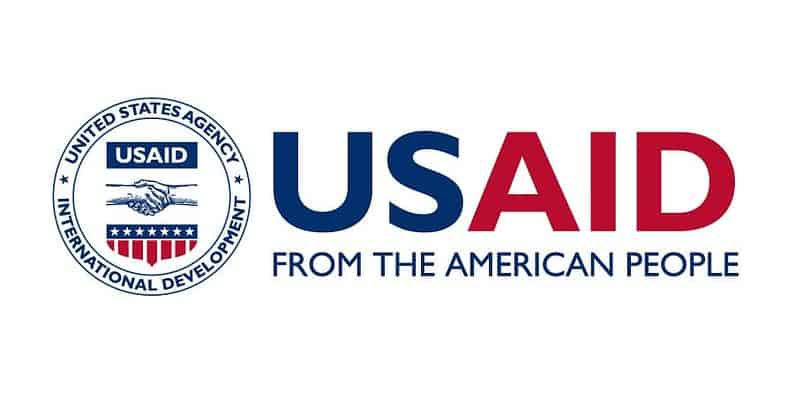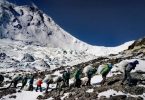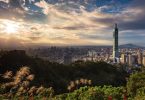PONAS. CAPEHART: Pradėkime nuo didelio paveikslo. Kaip ir kokiais būdais klimato kaita neproporcingai paveikia moteris?
ADMINISTRATORIAUS GALIOJIMAI: Na, pirmiausia leiskite padėkoti tiems, kurie rengia šį renginį.
Ir tiesiog pasakykite, kad tai yra mano 10-oji JTGA – ne, mano 11-oji JTGA, ir tai pirmas kartas, kai dalyvauju tokiame renginyje, kuris tik atkreipia dėmesį į pagrindinį daugelio problemų šaltinį ir būtinybę ieškoti sprendimų. .
Taigi pirmiausia norėčiau pasakyti, kad moterys, kaip ir visi marginalizuoti asmenys, taip pat visos pažeidžiamos populiacijos yra neproporcingai paveiktos klimato kaitos. Mes nuolat tai matome šios šalies mažumų bendruomenėse. Mes matome, kaip tai vyksta visame pasaulyje.
Jei pažvelgsite į faktinius aukų ar mirčių skaičių stichinių kritinių situacijų metu, pamatysite, kad didžiausia našta tenka moterims ir vaikams. Ir jūs galite pagalvoti, o, gerai, tai yra biologinis skirtumas ir galbūt jie negali įveikti potvynio bangų ar pan.
Tačiau tai daug kas susiję su lyčių normomis ir taip, jausmas, kad jums reikia leidimo, kad žinotumėte, ar galite išeiti ir būti įstrigę namuose. Apskritai, tai tiesiog iš tikrųjų yra atsakinga už tiek daug šeimos gerovės. Ir vėl neturėdamas galimybės labai svarbiai iškelti savo gerovę.
Jūs matote tai kiekvieną dieną, pažeidžiamumą, kai vanduo džiūsta, ir aš ką tik aplankiau tiek daug vietų – aš tikiu, kad daugelis iš jūsų taip pat – ten, kur net metai iš metų yra taip baisu, kaip kraštovaizdžiai skiriasi nuo tų, kurie buvo vos prieš dešimt metų. Tačiau vienas dalykas taip ir nepasikeitė – įprasta, kad į kaimo bendruomenes vandenį renkasi moterys, todėl šalia bendruomenės vandeniui nudžiūvus moterims tenka vaikščioti vis toliau.
Ir tai, žinoma, buvo siaubinga priemonė arba būdas, kuriuo moterys buvo nuolat patiriamos smurto dėl lyties kelyje. Taigi kuo toliau, tuo mažiau apsaugos, tuo labiau, kad tos kitos normos, kurios nėra jų akyse, atrodo, turi tiek daug bendro su klimato kaita per se – norma, rodanti, kad galima užpulti ar pulti moterį. – tada ta norma susikerta ir taip vėl reiškia nevienodą poveikį ir šio sektoriaus moterims.
PONAS. CAPEHART: Taigi kur pasaulyje šios problemos opiausios?
ADMINISTRATORIAUS GALIOJIMAI: Na, sunku išsirinkti. Pateiksiu jums trumpą apžvalgą po mano pastarojo meto horizontą arba bet kokią atgalinę horizonto versiją.
Per pastaruosius metus keliavau į Pakistaną, kai trečdalis šalies buvo po vandeniu dėl precedento neturinčių liūčių ir tirpstančių ledynų, kurie susidūrė iš karto, ir netinkamo pasiruošimo bei infrastruktūros derinio. Ir vėl, moterys dažnai lieka paskutinės, kad saugotų nuosavybę, saugotų gyvulius, kai vyrai ieško pagalbos. Aš turiu galvoje, visi yra paveikti siaubingai.
Iš ten keliaudami į šiaurinę Keniją ir Somalį, kad pamatytumėte penkis nesėkmingus lietaus sezonus iš eilės. Taigi visiška priešingybė tam, ką mačiau Pakistane, kuris yra tiesiog išdžiūvusi žemė. Milijonai gyvulių mirė nuo sausros Afrikos Kyšulyje. Galite pamanyti, kad pagrindinis poveikis bus gyvulių augintojams, kurie, žinoma, yra žmonės, auginantys gyvulius.
Ir tikrai, jūs matėte didelį šių vyrų savižudybių šuolį, nes jie tūkstantmečius augino gyvulius ir staiga visos jų ožkų ar kupranugarių bandos buvo taip išnaikintos.
Tačiau kalbant apie pasekmių šeimoms valdymą ir sunkią ūmią nepilną mitybą, kurią paliko jauni žmonės, ypač vaikai iki penkerių metų, moterys turėjo susidurti su nusivylusiais vyrais ir spręsti klausimą, kas bus su sūnumis, kurie įsivaizdavo, kad gyvenimo būdas tęsiasi ir dabar staiga galvoja: „Kaip galėčiau jiems suteikti alternatyvų gyvenimą, alternatyvų pašaukimą“, bet tada taip pat gali pabandyti rasti maisto mažiausiems.
Taigi vėl turiu galvoje, kad jis patenka į skirtingas vietas. Aš ką tik buvau, paskutinis, kurį jums siūlau, ką tik buvau Fidžyje.
Ir, žinoma, visoms Ramiojo vandenyno saloms – beveik visoms – tai yra egzistencinė grėsmė.
Kalbama apie tai, kad visos tautybės per kelerius metus turės išsiaiškinti, kur jos persikels, ką veikia, pavyzdžiui, ar gali gyventi tose šalies dalyse, ypač salose, kurios yra taip žemai.
Ir tik maži pavyzdžiai su augančia pramone, kurioje yra moterų.
Šiuo atveju aš sutikau moterį su grupe moterų, auginančių jūros vynuoges – kurios, beje, yra skanios.
Niekada anksčiau neturėjau jūros vynuogių. Ir jie taip didžiavosi savo jūros vynuogėmis. Ir USAID bando juos paremti, gauti mikropaskolą, kad jie galėtų kurti savo verslą, plėsti verslą.
Bet tik atsitiktinai, ir čia klimato kaita tiesiog iškyla kiekviename žingsnyje.
Sako, na, šiais laikais vienintelė bėda ta, kad dabar turime plaukioti valtimis vis toliau ir toliau, nes vandenynui šylant jis sušyla ypač arti kranto, todėl turime eiti toliau. Taigi mes einame toliau, kad gautume jūros vynuogių, o tai reiškia, kad daug ilgiau atsiliekame nuo visų kitų įsipareigojimų, kuriuos turime, kaip moterys, namuose.
Be to, naudojame degalais varomas valtis, todėl į orą išmetame daugiau teršalų, kai einame ir bandome išgauti šias jūros vynuoges, kad galėtume plėsti savo verslą.
Taigi, žinote, vėlgi, visur, kur pažvelgsite, Ramiojo vandenyno salos, Afrika, Azija – tai slegiančios bendruomenės.
PONAS. CAPEHART: Noriu gauti jūsų minimas mikropaskolas, noriu gauti pagalbą, kurią suteikia USAID. Tačiau ar šios problemos, apie kurias tik kalbate, yra daug besivystančių šalių, bet ar tai, apie ką kalbame, apsiriboja besivystančiu pasauliu?
ADMINISTRATORIAUS GALIOJIMAI: Ne, vargu ar, bet man tiesiog atsitinka...
PONAS. CAPEHART: Tai vadinama pagrindiniu klausimu.
ADMINISTRATORIAUS GALIOJIMAI: Turiu galvoje, kad gyvename, jau dvidešimt trečią stichinę nelaimę, kuri šiuo metu JAV kainavo daugiau nei milijardą dolerių.
Išgyvenome šilčiausią dieną, savaitę ir mėnesį, manau, tik per pastaruosius porą mėnesių. Pirmą kartą teko uždaryti tam tikras įmones, vasaros stovyklas ir galimybes jaunimui dėl gaisro dūmų, besitęsiančių į mūsų gyvenimą.
Ir vėl skirtingas poveikis. Tai gal mažas pavyzdys, bet kai vaikas negali eiti į stovyklą, tai bus dirbanti mama – daugumoje namų ūkių, tikrai mano – ji turės išsiaiškinti, kas – tai tarsi versija to, kas nutiko. su COVID.
Kai klimatas smogs nedideliais ar trumpalaikiais būdais, turinčiais rimtų padarinių sveikatai ir gyvenimo būdui, tai turės tvarkyti daugiafunkciniai namų darbuotojai.
Tačiau, turiu galvoje, taip pat negalima pervertinti finansinių padarinių, kuriuos dabar patiria kai kurioms Jungtinių Valstijų vietoms beveik kasdien daroma žala.
Taip atsitinka, kad ne tai, ką dirba USAID, nes mes dirbame užsienyje.
Ir mūsų darbas, pasakysiu, kad viena didžiausių įtampų ir iššūkių, su kuriais susiduriame, yra fiksuoti ištekliai ir ištekliai, kurie visiškai neatsilieka nuo vystymosi kliūčių, kurias sukelia klimato kaita.
Nors jų daugėja, mūsų ištekliai auga. Bet tu tiesiog negali suspėti. Tačiau kita problema yra ne tik tai. Tai yra tai, kad tiek daug mūsų išteklių skiriame žmonėms išlaikyti gyvas ekstremaliomis aplinkybėmis, tokiomis kaip Libijoje praėjusią savaitę – arba tas, kurias minėjau Pakistane ar Somalyje.
Ir ko nepadarytumėte, tai imtumėte visą tą humanitarinę pagalbą ir investuotų į nelaimėms atsparią infrastruktūrą arba į sausrai atsparias sėklas, arba į tas mikropaskolas smulkiesiems ūkininkams, kurie iš tikrųjų gali naudoti savo išmaniuosius telefonus, kad nuspėtų ekstremalias oro sąlygas ir bent jau sumažinti tuos nuostolius.
Taigi, tai, ką aprašiau, yra tam tikras skirtumas tarp atsparumo ir skubios pagalbos. Ir mes, kaip vyriausybė ir kaip donorų bendruomenė, esame labai įtempti – turiu galvoje, tai gražus dalykas, puiki privilegija bandyti padėti žmonėms išgyventi blogiausias jų gyvenimo akimirkas.
Tačiau darydami tai tokiu būdu, o tai yra nemenkas tarpas, jūs žinote, kad grįšite prie to. Ir tai ypač skauda širdį.
Nes anksčiau sakydavo, kad klimato šokas, bet dabar panašu, ar tai yra šokas, kai tai yra nuspėjama tam tikros šalies ūkininkavimo dalies ypatybė? Ir ko tai iš mūsų reikalauja?
Jei pyragas būtų didesnis, smarkiai padidintume savo investicijas į atsparumą, o tai ir turėtume daryti. Sunku neišgelbėti gyvybės siekiant išgelbėti gyvybes ilguoju laikotarpiu. Taigi mes tai subalansuojame kaip galime. Bet tai nėra smagus balansavimo veiksmas.
PONAS. CAPEHART: Jūs numatėte klausimą, kurį aš ketinu užduoti, ir nušokote nuo mikropaskolų dalies, todėl aš eisiu į priekį. Pakalbėkime apie ekonomikos vystymosi ir klimato kaitos ryšį.
Ar šios problemos yra glaudžiai susijusios ir kaip USAID jas sprendžia vienu metu?
ADMINISTRATORIAUS GALIOJIMAI: Na, aš turiu galvoje, sakyčiau, kad mes esame arba judame link, leiskite pasakyti, nes turime nuveikti ilgą kelią, kad atkreiptume dėmesį į klimato kaitą kaip į visų mūsų darbų dizaino bruožus.
Taigi vienas iš struktūrinių, galbūt keistų pavyzdžių yra tai, kad paėmėme savo Maisto saugumo ir atsparumo biurą ir sujungėme jį su klimato komanda. Ir štai kur – bet žmonėms akivaizdus ryšys nėra tobulas sutapimas, bet yra tonų – žemės ūkis yra pagrindinis išmetamųjų teršalų šaltinis, todėl tas emisijas reikia mažinti.
Ir, žinoma, klimato požiūriu pažangus žemės ūkis bus būdas išsaugoti maisto saugumą arba jį padidinti ateinančiais metais. Taigi tai vienas susijungimas. Tačiau kalbant apie išsilavinimą, tai yra numeris vienas. Turiu galvoje, kad mes visi, bet kuris iš mūsų, kurie turi vaikų, svarbiausias dalykas, kurį vaikai nori žinoti apie mus, yra ne tik tai, kas nutiks pasauliui, bet ir ką aš galiu dėl to padaryti?
Taigi net galvojant apie švietimą valdymo srityje – tai taip iš esmės destabilizuoja vyriausybes, kurios negali neatsilikti nuo klimato kaitos, tiek atsparumo, tiek kritinės padėties atžvilgiu, nes tai dar labiau padidina pasitikėjimo institucijomis praradimą, kurį matome daugelyje pasaulio šalių.
Tai ne tik stebėjimo technologijų eksportas iš KLR arba demokratijos, kurios puolamos kitomis priemonėmis.
Pasaulyje taip pat yra dalykų, kurių, kai vyriausybė negali suspėti, ji sustiprina tą cinizmą institucijų atžvilgiu. Taigi tai yra ilgas būdas pasakyti, kad mes atliekame USAID valdymo darbą, švietimą, visuomenės sveikatą, kuri yra visiškai susijusi su klimatu.
Žvelgiant į besikeičiančius maliarijos modelius, manau, kad PSO prognozuoja, kad iki 250,000 m. dar 2030 XNUMX žmonių mirs dėl su klimato kaita susijusių priežasčių – ar tai būtų karščio stresas, ar maliarija, ar vandens trūkumas, dėl to kylanti netinkama mityba.
Taigi, kaip agentūra, turime sutelkti dėmesį į atsparumą ir dėmesį klimato kaitai ir tai, ką tai reiškia bendruomenei visame kame, ką darome.
In a sense, USAID is a climate agency, even if we still have a climate team that works as a climate team per se, mainstreaming this agenda is what our missions are trying to do all around the world.
And this is not because I anticipate the, you know, the concerns of some maybe in our domestic politics on this – and I’m sure you’ll get there, but this isn’t USAID foisting anything.
This is the cri de coeur for you know, heard all around the world, that this is a game changer. Our development trajectories were going here – COVID hit and now we have what could feel like a COVID-like, not not of the same scale, but battering again and again and again.
So just as we’re now thinking differently about pandemic prevention, what should that lead us to think about when it comes to embedding climate in the mindset of all public spending and all notions of mobilizing, mobilizing private capital, because that’s, of course, going to be a big part of the solution.
So we’re that’s – it’s this mainstreaming and not having climate live over here. But given that it is this game changer and given it’s our host countries and the communities in which we work and of it works. It’s John F. Kennedy’s pleading gives us more of the tools to adapt to this shell-shocking phenomenon.
PONAS. CAPEHART: Well, I asked the question about economic development because, with economic development comes perhaps better lives, and better living conditions, which then can exacerbate the issues related to climate change.
So how do you – and I wrote it down really fast – that mainstreaming, how in mainstreaming climate in the things that you do. How do you find that balance between helping people help themselves, while at the same time not doing it in a way that exacerbates the climate problems that we all have to face?
ADMINISTRATORIAUS GALIOJIMAI: Yeah, and I mean, I think one example I think that you’re alluding to is, you know, as people get richer, they buy more meat and that causes, you know, more emissions or they travel more, they’re flying more there.
And absolutely, I mean, we’ve seen that the emissions trajectory in both the PRC and India reflected that.
Our emissions trajectory, back as we were bringing our economy online and modernizing, absolutely reflects that. So I think that is profound. I will say the fact that solar power, the cost of solar has come down by 85 percent. The cost of wind is down by 55 percent. Where we work, the demand signal for renewables is very, very significant – which doesn’t get it mediating some of the other features of getting wealthier.
But it does get to the urgency of making clean energy transitions as these prices come down. It is a better bet. And so again, when we have these exchanges on the Hill and it looks to some who are skeptical somehow still of climate programming, you know, that we’re bringing our green agenda to the countries in the communities we’re working in – no, it’s not like that at all.
They’re saying we can’t afford this other thing.
But actually, we can pop up a solar panel and have a water pump that we’ve been trying to get in this village. We can go off the grid in ways we never – where the state is not going to get here any time soon.
This was my experience out in Bekaa Valley in Lebanon, where USAID had worked to, you know, build a bunch of solar panels that powered electricity and ended up actually reducing tension between refugees who were being generously sheltered by Lebanese host communities, Syrian refugees, and the Lebanese.
Because they were no longer fighting over water because they had water because they had solar – but to attach to the grid, no way. And so then those tensions, who knows what would happen with that.
So the idea is that these investments are cost-effective over time, that actually you can develop, along the lines of what you’re describing, in a clean way.
I think the other aspects of consumption need to be dealt with as part of civic education and as part of norm work because it is true that in many, many societies, and again, including our own back in the day, as you increase your livelihoods, your income, consumables are a very attractive way to expand those new resources.
This feels like a high-class problem in most of the countries we’re talking about. I mean, I’m talking about working with small-scale farmers who are paying double this year for fertilizer than they were paying before Putin invaded Ukraine, who just need a little loan to be able to get access to some of those drought-resistant seeds that are going to increase yields by 25 percent.
But again, finding the resources to get them that. Getting the private sector interested in adaptation. But the question that we should be thinking now about, if we can be successful, if we can help them withstand the negative effects of climate change and the like here in America, grow jobs out of also these changes to their economies, then what?
Then we will be grappling with the kinds of things that have further fueled emissions in more recently developed countries.
PONAS. CAPEHART: As you alluded to many times, there’s a lot of good news related to the development of clean energy alternatives. That being said, though, global emissions once again hit a record high in 2022, and carbon dioxide in the atmosphere has risen to levels not seen in millions of years. Are we moving in the wrong direction despite glimmers of hope?
ADMINISTRATORIAUS GALIOJIMAI: Well, I mean, I think all of us can answer that question in two ways. And we talk to ourselves all day – on the one hand this, and on the other hand that. But what we can say is we’re certainly not moving fast enough. And you know what breaks my heart is, it’s a little bit like another version of the vicious cycle you were kind of describing.
But when you see the wildfires, and the rate of wildfires, and then all of the carbon emitted and all of the good that had been done with carbon emission reductions – and that being not washed away – whatever, smoked away, burned away – that’s heartbreaking because these investments are accelerating.
They are building momentum. So I think that, and that’s not the only thing that’s heartbreaking.
There’s so much that’s happening day to day and a little bit of the despondency, I think, setting in as well – as people just open the newspaper, and whether it’s in their own community or one further afield or even something like what happened in Libya, which just captures the imagination of, which was its own sui generis issue with regard to governance and infrastructure, but would not have happened that way but for the intensity of Storm Daniel, which is just being seen in so many communities.
But what I do think it’s important to come back to, at least as proof of concept, is that in Paris the projections – they were, we the world, were on a track to warm 4 degrees and we are now on a track to warm 2.5 degrees.
So that is a reflection of the agency that people have claimed over this trajectory. The problem is we need to curb warming at 1.5 degrees, but that delta from four to 2.5 should give people at least a sense that actually collectively we are doing things that are making a difference. There’s no doubt we are doing things that are making a difference.
If I could, though, I think the area that we have – I mean, as John Kerry likes to say, if we don’t get mitigation right and the carbon reductions right, there’ll be no planet to adapt. He makes a comment like that a lot.
We, at USAID, are in the mitigation and adaptation business, as is Secretary Kerry and his team. But I think in mitigation, what I think gives one hope is just how much the private sector has leaped in now recognizing that there’s money to be made. And I’d love to rely on people’s good intentions and their feeling of fellow humanity, but it’s much more reliable if they think there’s money to be made.
And that shift has occurred. And you see it in the IRA, which is already defying even the best projections and extrapolations that people did. I mean, this is going to have way more collateral effects and bring down carbon way more, I think, than people could have, just strictly speaking, anticipated because of a cascade now of private sector interest fueled and catalyzed by the underlying legislation.
And so too, as the prices come down again, there’s a virtuous cycle. Adaptation – we’re not we’re not there. And I don’t know if we’re ten years behind where we are on mitigation – where we are on mitigation.
Like it’s the same thing going to happen in ten years where we look back and say, oh, we lost all that time. Why couldn’t private-sector actors have seen as well that there’s good to be done and money to be made?
I guess if you have to think that way around the insurance industry in the agricultural sector, in Fintech, I mean, all these tools are going to be absolutely critical in particularly rural areas and those areas that are most vulnerable to climate change.
But about two percent of funding for adaptation comes from the private sector right now, and that has just got to change.
So President Biden and we have done a big call to action to the private sector, but it’s slow going. And even if you take – forget the specific sectors that have a direct nexus with the need to build resilience – look at it in even more stark terms. The market share that so many companies are hoping to capture is themselves going to have less money to spend, maybe in flight, maybe at war.
And so the positive of that is, hey, if we can help them adapt and be more resilient and where these emergencies happen, but don’t wallop communities in the same way and they bounce back, those are consumers that will be our consumers. But the negative is what if, you know, millions, tens of millions of consumers are taken offline because they are driven into poverty?
The predictions now are that 100 million more people driven into extreme poverty by 2030. But that’s within our hand, that adaptation. There’s so much less to, as I would say to my kids, there’s room to grow.
The areas that are the most troubling in some ways, there’s really room to grow. And you could see a cascade of the kind that we’ve seen on carbon mitigation.
PONAS. CAPEHART: Administrator Power, we got a minute and eight seconds and this will be the final question. The name of this conference is This is Climate: Women Leading the Charge. So how do you see women reshaping climate leadership?
ADMINISTRATORIAUS GALIOJIMAI: We, USAID, and Amazon, the company, not the forest, launched a gender equality fund, a gender equity fund at COP, and we launched it with $6 million in funding. And this is for women.
It’s for projects that will benefit women, it’s for projects that are driven by women in adaptation or in mitigation – the whole or the protection of natural ecosystems – but things broadly in the climate space.
And today we have the Visa Foundation and Reckitt, a company out of the United Kingdom, who have joined us and matched that initial – USAID put in $3 million, Amazon put in $3 million, and have added $6 million.
Why do I mention this? It’s not a huge amount of money yet. We are going to get up to $60 million, we hope, in rapid order.
This is part of another cascade that we would like to see. We’ve put out a request for proposals, incredible women leaders are putting proposals in.
These can be small projects. A lot of the climate finance right now is not going to small projects, it’s going to big international organizations. So working more with local partners is going to be absolutely key.
But these are going to be the success stories that are going to inspire people to invest more and to believe that change can come. And sadly, there are just not that many examples of climate finance facilities that are targeted and tailored toward women, even though women are bearing the greatest brunt.
And women, I think, in my experience, are doing the most innovative work in dealing with the consequences of climate change and trying to lower those consequences in the years ahead.
PONAS. CAPEHART: Samantha Power, the 19th Administrator of USAID, thank you very much for joining us today.
ADMINISTRATORIAUS GALIOJIMAI: Thanks, Jonathan.
What is USAID?
USAID stands for the United States Agency for International Development. It is an independent agency of the United States federal government that is primarily responsible for administering civilian foreign aid and development assistance. USAID’s mission is to promote economic and social development in countries around the world, with a particular focus on reducing poverty, promoting democracy, and addressing global challenges such as public health crises, environmental sustainability, and humanitarian crises.
Some of the key functions and activities of USAID include:
- Providing humanitarian assistance: USAID responds to natural disasters, conflicts, and other emergencies by providing humanitarian aid, including food, shelter, and medical supplies, to affected populations.
- Promoting economic development: USAID works to stimulate economic growth in developing countries by supporting projects and programs that create jobs, improve infrastructure, and foster private sector development.
- Supporting democracy and governance: USAID promotes democratic governance by providing technical assistance and support for fair and transparent elections, strengthening civil society organizations, and advocating for human rights and the rule of law.
- Advancing global health: USAID plays a crucial role in global health initiatives, including efforts to combat infectious diseases like HIV/AIDS, malaria, and COVID-19. It supports healthcare systems strengthening, family planning, and maternal and child health programs.
- Environmental sustainability: USAID works to address environmental challenges, including climate change and natural resource management, through projects that promote conservation, renewable energy, and sustainable agriculture.
- Education and capacity building: USAID invests in education and capacity-building programs to enhance the skills and knowledge of individuals and institutions in developing countries, thereby contributing to long-term development.
- Food security and agriculture: USAID supports programs aimed at improving food security, increasing agricultural productivity, and reducing hunger and malnutrition in vulnerable populations.
USAID operates in partnership with governments, non-governmental organizations, international organizations, and other stakeholders to achieve its development goals. It is often involved in projects and initiatives that aim to alleviate poverty, promote stability, and enhance the well-being of people in countries where it operates. The agency’s work is guided by the foreign policy objectives of the United States and the broader goal of fostering global development and progress.























